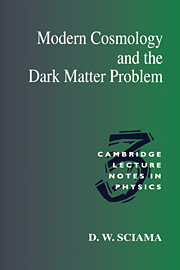
-
Select format
-
- Publisher:
- Cambridge University Press
- Publication date:
- January 2010
- April 1994
- ISBN:
- 9780511622731
- 9780521438483
- Dimensions:
- Weight & Pages:
- Dimensions:
- (228 x 152 mm)
- Weight & Pages:
- 0.308kg, 244 Pages
You may already have access via personal or institutional login
Book description
This book shows how modern cosmology and astronomy have led to the need to introduce dark matter in the universe. Some of this dark matter is in the familiar form of protons, electrons and neutrons, but most of it must have a more exotic form. The favoured, but not the only, possibility is neutrinos of non-zero rest mass, pair-created in the hot big bang and surviving to the present day. After a review of modern cosmology, this book gives a detailed account of the author's recent theory in which these neutrinos decay into photons which are the main ionising agents in hydrogen and nitrogen in the interstellar and intergalactic medium. This theory, though speculative, explains a number of rather different puzzling phenomena in astronomy and cosmology in a unified way and predicts values of various important quantities such as the mass of the decaying neutrino and the Hubble constant. Written by a cosmologist of the first rank, this topical book will be essential reading to all cosmologists and astrophysicists.
Reviews
‘This book is the epitome of clarity, and it will also make students think.’
Source: New Scientist
‘Both of these volumes are snapshots of an interesting moment in the development of theoretical cosmology.’
Source: Science ‘94
Contents
Metrics
Altmetric attention score
Full text views
Full text views help Loading metrics...
Loading metrics...
* Views captured on Cambridge Core between #date#. This data will be updated every 24 hours.
Usage data cannot currently be displayed.
Accessibility standard: Unknown
Why this information is here
This section outlines the accessibility features of this content - including support for screen readers, full keyboard navigation and high-contrast display options. This may not be relevant for you.
Accessibility Information
Accessibility compliance for the PDF of this book is currently unknown and may be updated in the future.


